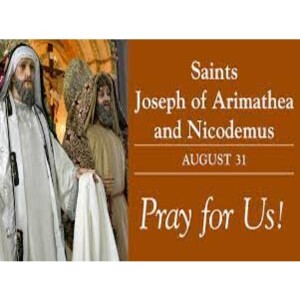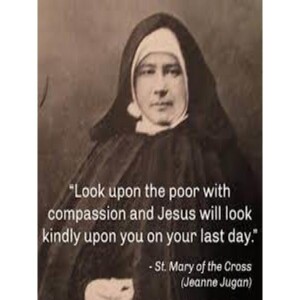Episodes

Tuesday Sep 05, 2023
Tuesday Sep 05, 2023
Stand in the Gap with us and Saint Teresa of Calcutta 9/5/2023
In 1950 she founded the Missionaries of Charity in Calcutta with an initial group of 12 followers. By 1969 it became an international association known to help “the poorest of the poor,” often by undertaking relief work after natural disasters. Ten years later she was awarded the Nobel Peace Prize.
Her new name was Teresa. In India she received a second call from God: to help the poor while living among them. She founded a new sisterhood, Missionaries of Charity. Mother Teresa and her helpers built homes for orphans, nursing homes for lepers and hospices for the terminally ill in Calcutta.
Mother Teresa created many homes for the dying and the unwanted from Calcutta to New York to Albania. She was one of the first to establish homes for AIDS victims. For more than 50 years, this courageous individual comforted the poor, the dying, and the unwanted around the world.
Mother Teresa of Calcutta, the tiny woman recognized throughout the world for her work among the poorest of the poor, was beatified October 19, 2003. Among those present were hundreds of Missionaries of Charity, the order she founded in 1950, as a diocesan religious community. Today the congregation also includes contemplative sisters and brothers, and an order of priests.
Born to Albanian parents in what is now Skopje, Macedonia, Gonxha (Agnes) Bojaxhiu was the youngest of the three children who survived. For a time, the family lived comfortably, and her father’s construction business thrived. But life changed overnight following his unexpected death.

Tuesday Sep 05, 2023
Tuesday Sep 05, 2023
Eucharistic Miracle, Tixtla, Mexico
4 God speaking through St. Paul, Finally, brethren, we beseech and exhort you in the Lord Jesus, that as you learned from us how you ought to live and to please God, just as you are doing, you do so more and more. 2 For you know what instructions we gave you through the Lord Jesus. 3 For this is the will of God, your sanctification:[a] that you abstain from immorality;[b] 4 that each one of you know how to control his own body in holiness and honor, 5 not in the passion of lust like heathen who do not know God; 6 that no man transgress, and wrong his brother in this matter,[c] because the Lord is an avenger in all these things, as we solemnly forewarned you. 7 For God has not called us for uncleanness, but in holiness. 8 Therefore whoever disregards this, disregards not man but God, who gives his Holy Spirit to you. Love and prayers in Christ, GregoryMary
On October 12, 2013, H.E. Most Rev. Alejo Zavala Castro, Bishop of the Diocese of Chilpancingo-Chilapa, announced through a Pastoral Letter the recognition of the Eucharistic Miracle that occurred at Tixtla, on October 21, 2006. In the letter we read: “This manifestation brings to us a marvelous sign of the love of God that confirms the Real presence of Jesus in the Eucharist... In my role as Bishop of the Diocese I recognize the supernatural character of the series of events relating to the Bleeding Host of Tixtla... I declare the case as a “Divine Sign...”.

Monday Sep 04, 2023
Monday Sep 04, 2023
Stand in the Gap with us and Saint Rose of Viterbo 9/4/2023
St. Rose was born in Viterbo (present day Italy) around 1233 C.E. Little is known about her life. She was born to a poor but devout family. Since a child, she held a deep love and passion for prayer and serving poor.
At the age of 10, the Blessed Virgin Mary was said to have told Rose to join the Third Order of St. Francis (a Franciscan lay order). So she donned the habit of the T.O.S.F. and as instructed by the Blessed Virgin, preached and emphasized penance and loyalty to the Catholic Church.
At the age of 10, she became a Secular Franciscan and soon began preaching in the streets about sin and the sufferings of Jesus. Viterbo, her native city, was then in revolt against the pope. When Rose took the pope's side against the emperor, she and her family were exiled from the city.
She is the patron saint of embroiderers, gardeners, florists, people who are harassed for their piety, and those suffering family problems. She is the patroness of the Americas, the indigenous people of the Americas, and of Peru, India, and the Philippines.
Rose was also known to be a visionary. On December 5, 1250, she foretold the death of the emperor which was fulfilled 8 days later on December 13. According to surviving evidence, Rose went to the city of Vitorchiano which was possessed by a sorceress. She not only converted the whole town, but the sorceress herself when she stood unharmed on a burning pyre for three hours.
Even as a child, Rose had a great desire to pray and to aid the poor. While still very young, she began a life of penance in her parents’ house. She was as generous to the poor as she was strict with herself. At the age of 10, she became a Secular Franciscan and soon began preaching in the streets about sin and the sufferings of Jesus.

Monday Sep 04, 2023
Monday Sep 04, 2023
Join John Carpenter, Domals Hartley, and the Deeper Truth research team as they begin to cover the many events in Quito, Ecudaor after an initial start back in Spain.

Sunday Sep 03, 2023
Sunday Sep 03, 2023
Stand in the Gap with us and Saint Gregory the Great 9/3/2023
His epithet “the Great” reflects his status as a writer as well as a ruler. As the fourth and final of the traditional Latin Fathers of the Church, Gregory was the first exponent of a truly medieval, sacramental spirituality.
Patron Saint of Musicians, Singers, Students, and Teachers, St. Gregory the Great is a Doctor of the Church and was Pope from 590 to 604 AD.
When a woman laughed at the Eucharist, thinking it was only bread, St. Gregory prayed and the host turned to flesh. The Catholic Church teaches that after the consecration takes place at Mass, the Eucharistic host substantially changes into the body, blood, soul and divinity of Jesus Christ.
Gregory was the prefect of Rome before he was 30. After five years in office he resigned, founded six monasteries on his Sicilian estate, and became a Benedictine monk in his own home at Rome.
Ordained a priest, Gregory became one of the pope’s seven deacons, and also served six years in the East as papal representative in Constantinople. He was recalled to become abbot, but at the age of 50 was elected pope by the clergy and people of Rome.
Gregory was direct and firm. He removed unworthy priests from office, forbade taking money for many services, emptied the papal treasury to ransom prisoners of the Lombards and to care for persecuted Jews and the victims of plague and famine. He was very concerned about the conversion of England, sending 40 monks from his own monastery. He is known for his reform of the liturgy, and for strengthening respect for doctrine. Whether he was largely responsible for the revision of “Gregorian” chant is disputed.

Saturday Sep 02, 2023
Saturday Sep 02, 2023
Stand in the Gap with us & Blessed John Francis Burté and Companions 9/2/2023
These priests were victims of the French Revolution. Though their martyrdom spans a period of several years, they stand together in the Church’s memory because they all gave their lives for the same principle. The Civil Constitution of the Clergy (1791) required all priests to take an oath which amounted to a denial of the faith. Each of these men refused and was executed.
John Francis Burté became a Franciscan at 16 and after ordination taught theology to the young friars. Later he was guardian of the large Conventual friary in Paris until he was arrested and held in the convent of the Carmelites.
These priests were victims of the French Revolution. Though their martyrdom spans a period of several years, they stand together in the Church’s memory because they all gave their lives for the same principle. In 1791, the Civil Constitution of the Clergy required all priests to take an oath which amounted to a denial of the faith. Each of these men refused and was executed.
John Francis Burté became a Franciscan at 16 and after ordination taught theology to the young friars. Later he was guardian of the large Conventual friary in Paris until he was arrested and held in the convent of the Carmelites.
Appolinaris of Posat was born in 1739 in Switzerland. He joined the Capuchins and acquired a reputation as an excellent preacher, confessor, and instructor of clerics. Preparing for his assignment to the East as a missionary, he was in Paris studying Oriental languages when the French Revolution began. Refusing the oath, he was swiftly arrested and detained in the Carmelite convent.

Friday Sep 01, 2023
Friday Sep 01, 2023
Stand in the Gap with us and Saint Giles9/1/2023
St Giles is the patron saint for disabled people, lepers, beggars and blacksmiths and his feast day is celebrated on the first of September.
Most artwork depicts him with is deer. The King's hunters, who had looked for a place of refuge for the night, finally discovered his solitude. The next day an arrow was shot at a deer, but instead wounded the saint, thus becoming the patron saint of handicap persons.
In medieval art, he is depicted with his symbol, the hind. His emblem is also an arrow.
Despite the fact that much about Saint Giles is shrouded in mystery, we can say that he was one of the most popular saints in the Middle Ages. Likely, he was born in the first half of the seventh century in southeastern France. That is where he built a monastery that became a popular stopping-off point for pilgrims making their way to Compostela in Spain, and the Holy Land.
In England, many ancient churches and hospitals were dedicated to Giles. One of the sections of the city of Brussels is named after him. In Germany, Giles was included among the so-called 14 Holy Helpers, a popular group of saints to whom people prayed, especially for recovery from disease, and for strength at the hour of death.
Also among the 14 were Saints Christopher, Barbara, and Blaise. Interestingly, Giles was the only non-martyr among them. Devotion to the “Holy Helpers” was especially strong in parts of Germany and in Hungary and Sweden. Such devotion made his popularity spread. Giles was soon invoked as the patron of the poor and the disabled.

Thursday Aug 31, 2023
Thursday Aug 31, 2023
Stand in the Gap With us and Saints Joseph of Arimathea and Nicodemus 6/31/2023
Following the death of Jesus, Joseph obtained Jesus' body from Pilate, wrapped it in fine linen and buried it. For these reasons, Joseph is considered the patron saint of funeral directors and pallbearers.
For instance, after Joseph asked Pilate for the body of the Christ and prepared the body with Nicodemus' help, Christ's body was delivered to a new tomb that Joseph had built for himself.
Joseph of Arimathea was a wealthy Jewish man who buried the body of Jesus Christ after the Crucifixion.
After Jesus' crucifixion, Nicodemus assists Joseph of Arimathea in laying Jesus' body in a nearby tomb (John 19:39–42). He brings along a mixture of myrrh and aloes to anoint him for the entombment.
Nicodemus became a saint because he stood up and defended Jesus when he was accused before the Jewish authorities (Jn 7: 45-51) and also because he helped Joseph Arimathea prepare Christ's body for burial after his crucifixion.
Joseph had a faith in Jesus and was considered a disciple. This happened despite his being a member of the Sanhedrin, who were, as a group, bitterly opposed to Christ. However, Joseph held to his belief in Jesus and had a faith in Him despite his surroundings.
But now, though Joseph of Arimathea had intirely devoted himself to the sect of the Pharisees, yet was he not addicted to the vices which too evidently appeared among them, especially hypocrisy; for he was really just in all his dealings, pious without ostentation, and very charitable in private: insomuch that he ...
The actions of these two influential Jewish leaders give insight into the charismatic power of Jesus and his teachings—and the risks that could be involved in following him.

Wednesday Aug 30, 2023
Wednesday Aug 30, 2023
Stand in the Gap with us and Saint Jeanne Jugan 8/30/2023
As our aging population continues to grow and dignity at the end of life is increasingly threatened, Jeanne Jugan offers herself as a friend and patron of the elderly. She is a Saint for old age.
Jeanne Jugan was not canonized because she founded a religious congregation, because her work has spread all over the world, or even because the elderly need a friend today more than ever. She was declared a Saint because she practiced heroic virtue.
At the age of 15 or 16, Jeanne became a kitchen maid for a family that not only cared for its own members, but also served poor, elderly people nearby. Ten years later, Jeanne became a nurse at the hospital in Le Rosais. Soon thereafter, she joined a third order group founded by Saint John Eudes.
“Refuse God nothing …We must do all through love.”
Lacking home religious instruction, she is attracted to a new type of stability: nuns who run a children's village. Gruesome stories of Christian saints and martyrs keep Jeanne interested in the local chapel, which is a mile from her barracks.
Born in northern France during the French Revolution—a time when congregations of women and men religious were being suppressed by the national government, Jeanne would eventually be highly praised in the French academy for her community’s compassionate care of elderly poor people.
When Jeanne was three and a half years old, her father, a fisherman, was lost at sea. Her widowed mother was hard pressed to raise her eight children alone; four died young. At the age of 15 or 16, Jeanne became a kitchen maid for a family that not only cared for its own members, but also served poor, elderly people nearby. Ten years later, Jeanne became a nurse at the hospital in Le Rosais. Soon thereafter, she joined a third order group founded by Saint John Eudes.

Tuesday Aug 29, 2023
Tuesday Aug 29, 2023
Martyrdom of Saint John the Baptist 8/29/2023
St. John the Baptist was an ascetic Jewish prophet known in Christianity as the forerunner of Jesus. John preached about God's Final Judgment and baptized repentant followers in preparation for it. Jesus was among the recipients of his rite of baptism.
John was sentenced to death and subsequently beheaded by Herod Antipas sometime between 28 and 36 AD, after he rebuked him for divorcing his wife, Phasaelis, and unlawfully taking Herodias, the wife of his brother, Herod Philip I
In fact, they were cousins. But they were so much more than just cousins. According to the New Testament, John the Baptist, who was born before Jesus, also had a miracle birth.
The drunken oath of a king with a shallow sense of honor, a seductive dance and the hateful heart of a queen combined to bring about the martyrdom of John the Baptist. The greatest of prophets suffered the fate of so many Old Testament prophets before him: rejection and martyrdom. The “voice crying in the desert” did not hesitate to accuse the guilty, did not hesitate to speak the truth. But why? What possesses a man that he would give up his very life?
